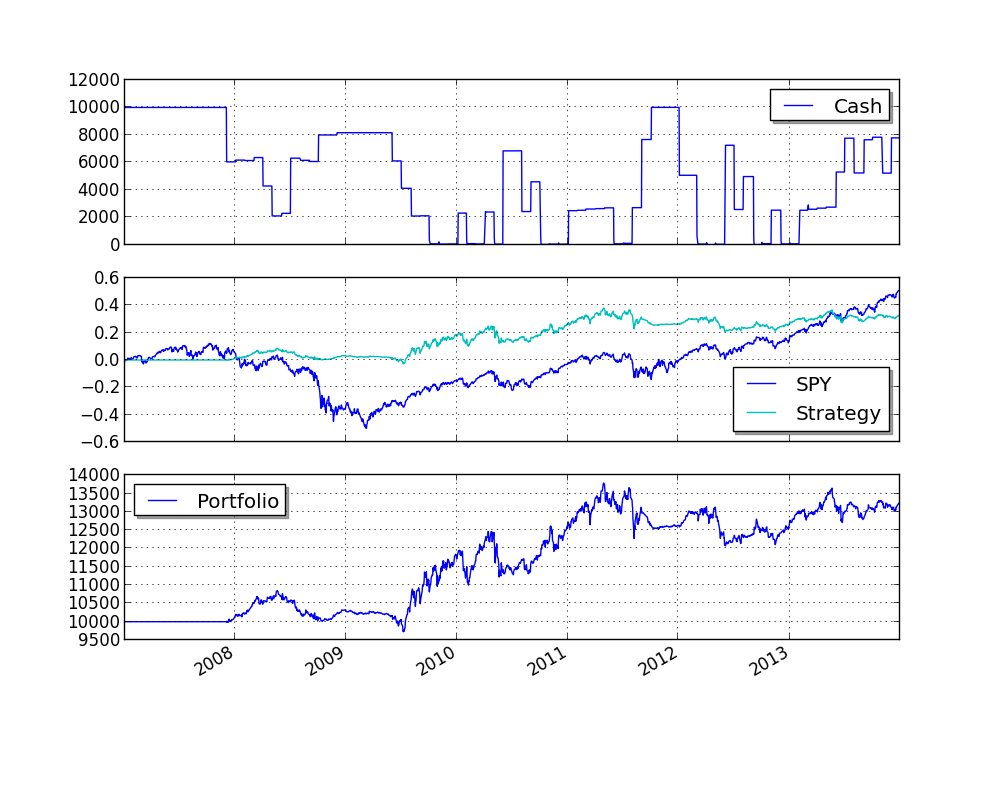Market Timing Using Moving-Average Crossovers¶
- This example is inspired on the Market Timing / GTAA model described in:
The stragegy supports analyzing more than one instrument per asset class, and selects the one that has highest returns in the last month.
from pyalgotrade import strategy
from pyalgotrade import plotter
from pyalgotrade.tools import yahoofinance
from pyalgotrade.technical import ma
from pyalgotrade.technical import cumret
from pyalgotrade.stratanalyzer import sharpe
from pyalgotrade.stratanalyzer import returns
class MarketTiming(strategy.BacktestingStrategy):
def __init__(self, feed, instrumentsByClass, initialCash):
super(MarketTiming, self).__init__(feed, initialCash)
self.setUseAdjustedValues(True)
self.__instrumentsByClass = instrumentsByClass
self.__rebalanceMonth = None
self.__sharesToBuy = {}
# Initialize indicators for each instrument.
self.__sma = {}
for assetClass in instrumentsByClass:
for instrument in instrumentsByClass[assetClass]:
priceDS = feed[instrument].getPriceDataSeries()
self.__sma[instrument] = ma.SMA(priceDS, 200)
def _shouldRebalance(self, dateTime):
return dateTime.month != self.__rebalanceMonth
def _getRank(self, instrument):
# If the price is below the SMA, then this instrument doesn't rank at
# all.
smas = self.__sma[instrument]
price = self.getLastPrice(instrument)
if len(smas) == 0 or smas[-1] is None or price < smas[-1]:
return None
# Rank based on 20 day returns.
ret = None
lookBack = 20
priceDS = self.getFeed()[instrument].getPriceDataSeries()
if len(priceDS) >= lookBack and smas[-1] is not None and smas[-1*lookBack] is not None:
ret = (priceDS[-1] - priceDS[-1*lookBack]) / float(priceDS[-1*lookBack])
return ret
def _getTopByClass(self, assetClass):
# Find the instrument with the highest rank.
ret = None
highestRank = None
for instrument in self.__instrumentsByClass[assetClass]:
rank = self._getRank(instrument)
if rank is not None and (highestRank is None or rank > highestRank):
highestRank = rank
ret = instrument
return ret
def _getTop(self):
ret = {}
for assetClass in self.__instrumentsByClass:
ret[assetClass] = self._getTopByClass(assetClass)
return ret
def _placePendingOrders(self):
remainingCash = self.getBroker().getCash() * 0.9 # Use less chash just in case price changes too much.
for instrument in self.__sharesToBuy:
orderSize = self.__sharesToBuy[instrument]
if orderSize > 0:
# Adjust the order size based on available cash.
lastPrice = self.getLastPrice(instrument)
cost = orderSize * lastPrice
while cost > remainingCash and orderSize > 0:
orderSize -= 1
cost = orderSize * lastPrice
if orderSize > 0:
remainingCash -= cost
assert(remainingCash >= 0)
if orderSize != 0:
self.info("Placing market order for %d %s shares" % (orderSize, instrument))
self.marketOrder(instrument, orderSize, goodTillCanceled=True)
self.__sharesToBuy[instrument] -= orderSize
def _logPosSize(self):
totalEquity = self.getBroker().getEquity()
positions = self.getBroker().getPositions()
for instrument in self.getBroker().getPositions():
posSize = positions[instrument] * self.getLastPrice(instrument) / totalEquity * 100
self.info("%s - %0.2f %%" % (instrument, posSize))
def _rebalance(self):
self.info("Rebalancing")
# Cancel all active/pending orders.
for order in self.getBroker().getActiveOrders():
self.getBroker().cancelOrder(order)
cashPerAssetClass = self.getBroker().getEquity() / float(len(self.__instrumentsByClass))
self.__sharesToBuy = {}
# Calculate which positions should be open during the next period.
topByClass = self._getTop()
for assetClass in topByClass:
instrument = topByClass[assetClass]
self.info("Best for class %s: %s" % (assetClass, instrument))
if instrument is not None:
lastPrice = self.getLastPrice(instrument)
cashForInstrument = cashPerAssetClass - self.getBroker().getShares(instrument) * lastPrice
# This may yield a negative value and we have to reduce this
# position.
self.__sharesToBuy[instrument] = int(cashForInstrument / lastPrice)
# Calculate which positions should be closed.
for instrument in self.getBroker().getPositions():
if instrument not in topByClass.values():
currentShares = self.getBroker().getShares(instrument)
assert(instrument not in self.__sharesToBuy)
self.__sharesToBuy[instrument] = currentShares * -1
def getSMA(self, instrument):
return self.__sma[instrument]
def onBars(self, bars):
currentDateTime = bars.getDateTime()
if self._shouldRebalance(currentDateTime):
self.__rebalanceMonth = currentDateTime.month
self._rebalance()
self._placePendingOrders()
def main(plot):
initialCash = 10000
instrumentsByClass = {
"US Stocks": ["VTI"],
"Foreign Stocks": ["VEU"],
"US 10 Year Government Bonds": ["IEF"],
"Real Estate": ["VNQ"],
"Commodities": ["DBC"],
}
# Download the bars.
instruments = ["SPY"]
for assetClass in instrumentsByClass:
instruments.extend(instrumentsByClass[assetClass])
feed = yahoofinance.build_feed(instruments, 2007, 2013, "data", skipErrors=True)
strat = MarketTiming(feed, instrumentsByClass, initialCash)
sharpeRatioAnalyzer = sharpe.SharpeRatio()
strat.attachAnalyzer(sharpeRatioAnalyzer)
returnsAnalyzer = returns.Returns()
strat.attachAnalyzer(returnsAnalyzer)
if plot:
plt = plotter.StrategyPlotter(strat, False, False, True)
plt.getOrCreateSubplot("cash").addCallback("Cash", lambda x: strat.getBroker().getCash())
# Plot strategy vs. SPY cumulative returns.
plt.getOrCreateSubplot("returns").addDataSeries("SPY", cumret.CumulativeReturn(feed["SPY"].getPriceDataSeries()))
plt.getOrCreateSubplot("returns").addDataSeries("Strategy", returnsAnalyzer.getCumulativeReturns())
strat.run()
print "Sharpe ratio: %.2f" % sharpeRatioAnalyzer.getSharpeRatio(0.05)
print "Returns: %.2f %%" % (returnsAnalyzer.getCumulativeReturns()[-1] * 100)
if plot:
plt.plot()
if __name__ == "__main__":
main(True)
This is what the output should look like:
2014-05-25 22:36:59,740 yahoofinance [INFO] Creating data directory
2014-05-25 22:36:59,740 yahoofinance [INFO] Downloading SPY 2007 to data/SPY-2007-yahoofinance.csv
2014-05-25 22:37:06,332 yahoofinance [INFO] Downloading VTI 2007 to data/VTI-2007-yahoofinance.csv
2014-05-25 22:37:10,666 yahoofinance [INFO] Downloading DBC 2007 to data/DBC-2007-yahoofinance.csv
2014-05-25 22:37:13,102 yahoofinance [INFO] Downloading IEF 2007 to data/IEF-2007-yahoofinance.csv
2014-05-25 22:37:19,394 yahoofinance [INFO] Downloading VEU 2007 to data/VEU-2007-yahoofinance.csv
2014-05-25 22:37:27,378 yahoofinance [INFO] Downloading VNQ 2007 to data/VNQ-2007-yahoofinance.csv
2014-05-25 22:37:32,771 yahoofinance [INFO] Downloading SPY 2008 to data/SPY-2008-yahoofinance.csv
2014-05-25 22:37:38,326 yahoofinance [INFO] Downloading VTI 2008 to data/VTI-2008-yahoofinance.csv
2014-05-25 22:37:42,262 yahoofinance [INFO] Downloading DBC 2008 to data/DBC-2008-yahoofinance.csv
.
.
.
2013-12-02 00:00:00 strategy [INFO] Rebalancing
2013-12-02 00:00:00 strategy [INFO] Best for class US Stocks: VTI
2013-12-02 00:00:00 strategy [INFO] Best for class Commodities: None
2013-12-02 00:00:00 strategy [INFO] Best for class US 10 Year Government Bonds: None
2013-12-02 00:00:00 strategy [INFO] Best for class Foreign Stocks: VEU
2013-12-02 00:00:00 strategy [INFO] Best for class Real Estate: None
2013-12-02 00:00:00 strategy [INFO] Placing market order for -1 VTI shares
2013-12-02 00:00:00 strategy [INFO] Placing market order for -39 VNQ shares
Sharpe ratio: -0.06
Returns: 32.97 %
This is what the plot should look like:
